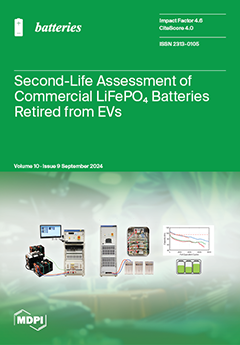A disordered sodium borohydride (NaBH
4) environment to facilitate Na
+ mobility was achieved by partially hydrolyzing NaBH
4 and this significantly improved Na
+ ionic conductivity to 10
−3 S cm
−1 at 75 °C. The reaction rate of NaBH
4
[...] Read more.
A disordered sodium borohydride (NaBH
4) environment to facilitate Na
+ mobility was achieved by partially hydrolyzing NaBH
4 and this significantly improved Na
+ ionic conductivity to 10
−3 S cm
−1 at 75 °C. The reaction rate of NaBH
4 self-hydrolysis, however, is determined by several parameters, including the reaction temperature, the molar ratio between NaBH
4 and H
2O, and the pH value; but these factors are hard to control. In this paper, poly(ethylene oxide) (PEO), capable of retaining H
2O through hydrogen bonding, was used in an attempt to better control the amount of H
2O available for NaBH
4 self-hydrolysis. This strategy led to the ionic conductivity of 1.6 × 10
−3 S cm
−1 at 45 °C with a Na
+ transference number of 0.54. The amorphous nature of the PEO matrix in hydrolyzed NaBH
4 is also believed to provide a conduction path for fast Na
+ conduction.
Full article





